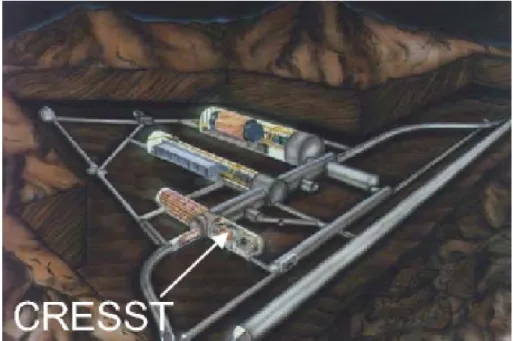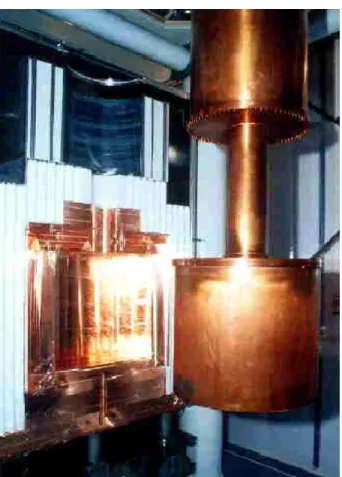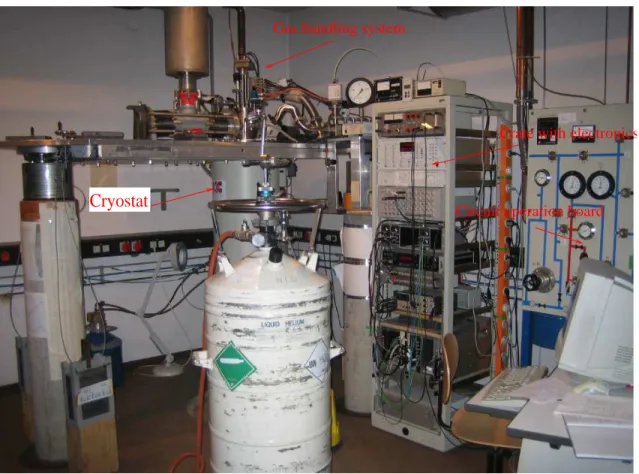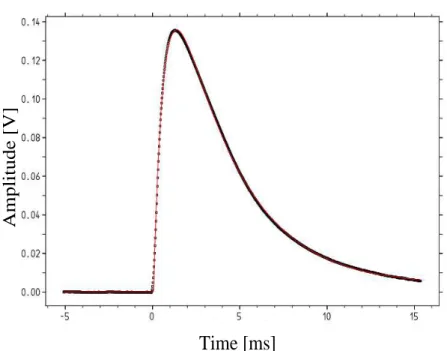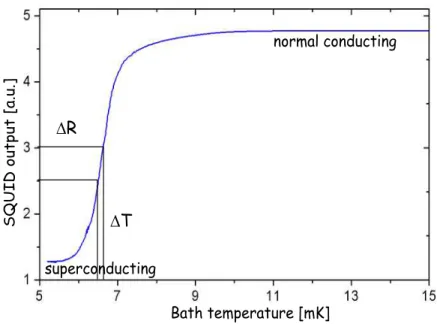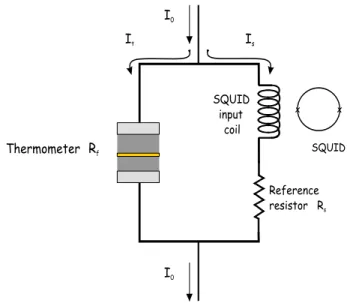Investigation of ZnWO Crystals as an Absorbers in the CRESST Dark Matter Search
Masterarbeit
zur Erlangung des akademischen Grades Master of Science in Physics
(M.Sc)
an der Universit¨at Siegen im Fachbereich Physik
vorgelegt von IRINA BAVYKINA
Unter der Leitung von Professor Dr. Claus Grupen
March
2006
...Dedicated To
My Grandfather.
Abstract
The goal of the CRESST Dark Matter search experiment is the direct detection of Weakly Interacting Massive Particles (WIMP) via their elastic scattering off the nuclei in the target absorber. The expected WIMP event rates are supposed to be less than 0.1 event per kg and per day [1], while the background rates in unshielded detectors operated at the surface of the Earth are orders of magnitude higher. Therefore, it is of crucial importance to sup- press background signals which would hide or mimic (in the case of neutrons) the WIMP signal. In the second phase of the CRESST experiment an active signal-to-background discrimination is achieved with cryogenic scintillating calorimeters. The low temperature detectors employed by CRESST can discriminate between electron recoil events (caused by -,
-,
-particles) and nuclear recoil events (caused by WIMPs and neutrons) by the simultaneous measurement of phonon and scintillation light signals.
A high scintillation yield in the mK temperature range is a key criterion in the choice of a scintillating absorber in the CRESST experiment. appears to be a satis- factory choice, providing high light yield and an excellent discrimination between elec- tron and nuclear recoil. Furthermore, as maximum recoil energy of WIMP-induced and neutron-induced events differs for different types of nucleon, using different target mate- rials would allow determination of the WIMP mass and to obtain information about the structure and dynamics of the WIMP halo in our galaxy. Therefore, it is beneficial to have targets with a variety of nuclei, and also targets that are similar with only one nucleus dif- ferent.
is a very interesting material in this regard. The combination of
and could form the basis of the first multi-target detector capable of WIMP iden- tification through material signature.
In this work the properties and quality of single crystals were studied. In particular, the quenching factor of was measured for the first time. The results on a comparative examination of the luminescence light yield of and
scintillators measured by [2] are presented.
i
Contents
Abstract i
1 Introduction to the Dark Matter problem 1
1.1 Cosmological motivation . . . . 1
1.2 DM candidates . . . . 9
1.3 Direct detection of DM . . . . 12
2 Direct Dark Matter experiments and CRESST 17 2.1 Sources of the background radiation . . . . 17
2.2 Current direct detection experiments . . . . 21
2.3 CRESST experimental setup . . . . 25
3 CRESST detector model 29 3.1 Cryogenic calorimeter . . . . 29
3.2 Signal formation . . . . 31
3.3 Calorimeter model . . . . 33
3.4 CRESST detector concept . . . . 40
4 ZnWO crystals for the simultaneous phonon-light detection 47 4.1 Luminescence light yield of ZnWO
and CaWO
scintillators . . . . 50
4.2 ZnWO
quenching factor measurements . . . . 51
4.3 Data analysis . . . . 55
4.4 Results . . . . 57
5 Conclusions and perspectives 64
A
dilution refrigerators 66
B Heat capacities 71
Chapter 1
Introduction to the Dark Matter problem
The question of what makes up the mass density of the Universe is practically as old as extragalactic astronomy. The kinematics of galaxies and galaxy clusters suggest that the dynamic mass involved is far greater than the observable luminous mass [3]. Although the first hints of the existence of the missing matter were observed by the Swiss astronomer Zwicky already in the 1930s, only recent years has it become known that the Universe, in fact, is dominated by particles whose nature is unknown and which have never been directly observed. Considerable experimental effort is in progress throughout the world to elucidate the yet unknown nature of the missing matter of the Universe, the so-called Dark Matter (DM). It is without doubt one of the most stunning astrophysical mysteries.
This chapter gives an introduction to standard cosmology. The indirect evidence for the existence of DM in the Universe, the most popular DM candidates and main limitations on the direct DM detection will be presented.
1.1 Cosmological motivation
Our present understanding of the Universe is based on a fundamental picture, the so-called Big Bang Scenario, first proposed in 1927 by the Belgian cosmologist Georges Lemaitre.
As far as we know evolution of the Universe began with a singularity called Big Bang.
Since then (for about 14 billion years) the Universe has been expanding. Immediately following the Big Bang, the Universe contained an extremely hot and dense plasma of elementary particles, frequently reacting among each other. As during expansion of the Universe the density of these particles and also their energy (or simply the temperature of the Universe) became lower, reactions among particles froze out. The course and the outcome of these reactions in the early Universe therefore determined in what form parti- cles and thus matter survived. Small fluctuations in particle density were the seeds for the
1
2 Chapter 1. Introduction to the Dark Matter problem
formation of galaxies, galaxy clusters, and of the other structures in the Universe.
A typical galaxy such as our Milky Way contains of the order of 10
stars, together with clouds of gas and dust. Various forms of galaxies are observed, the most common being elliptical or spiral galaxies. In spiral galaxies a central spherical hub (or bulge) is surrounded by a flattened structure or disk in the form of spiral arms. The latter are moving in roughly circular orbits. The disk is stabilized against collapse by angular momentum conservation. Figure 1.1 shows a picture of the spiral galaxy M31, which is similar in structure to the Milky Way. The total number of observable galaxies is enormous (
).
Fig. 1.1: The spiral galaxy M31. Figure taken from [4]
Galaxies occur in clusters and superclusters. In Table 1.1 the approximate sizes and masses in the Universe are presented.
The cosmological model of the Universe has three fundamental ingredients [5]:
Einstein equation, relating the geometry of the Universe with its matter and energy content;
metric, describing the structure of space time;
equation of states, specifying the physical properties of matter and energy content.
The Einstein field equation reads
"!
(1.1)
1.1. Cosmological motivation 3
Table 1.1: Approximate sizes and masses in the Universe
(1 parsec = 1pc = 3.09
m = 3.26 ly)
Radius Mass
Sun 7 10
m 2 10
kg =
Galaxy 15 kpc 10
Cluster 5 Mpc 10
Supercluster 50 Mpc 10
Universe 4200 Mpc 10
where and R are the Ricci tensor and scalar, respectively,
is the metric tensor,
is Newton’s constant,
is the energy tensor, and
is the cosmological constant. One has to specify the symmetries of the Universe in order to solve the Einstein equation . Standard cosmology assumes a spatially homogeneous and isotropic Universe. This is also indicated by observations. Approximately 400.000 years after Big Bang, when the Universe became cool enough (such that electrons and nuclei started to form atoms) photons and matter decoupled: As the photon energy was no longer sufficient to ionize atoms, the Universe turned transparent. Today we see these photons as the Cosmic Microwave Background (CMB). Anisotropy in the temperature of the CMB reflects the size of density fluctuations in the Universe at the time of the decoupling between photons and matter. CMB obser- vations have shown remarkable isotropy of the Universe. Evidence of the homogeneity comes from galaxy survey observations.
It can be shown that all spatially isotropic and homogeneous spaces can be described by the Friedmann-Robertson-Walker (FRW) metric [6], which is given by
(1.2) Here d
is the solid angle d
= d
!+ sin
"d
#$,
$is the so-called scale factor and the constant
= 0,
%1, describing the spatial curvature, stands for flat, closed, or open Universes, respectively.
In 1929, observing the spectral lines from the distant galaxies, Hubble discovered the expansion of the Universe. The spectral lines due to the Doppler effect are shifted towards the red end of the spectrum. The magnitude of the shift depends on the apparent brightness of the galaxy and hence on their distance [7]. A linear relation between the velocity of the recession of the galaxy
&and the distance r is:
& !
(1.3) where
is the Hubble constant.
4 Chapter 1. Introduction to the Dark Matter problem
In the early Universe the energy density was very smooth, as evidenced by the isotropy of the CMB. It should therefore be adequate to use the perfect fluid hydrodynamical ap- proximation of the cosmic fluid. In a perfect fluid, there exists the frame, the comoving frame, where the fluid looks perfectly isotropic. The equation of the motion of a perfect fluid with isotropic pressure in the expanding Universe yields the Friedmann equation (which is the solution of the Einstein equation with FRW metric):
!
(1.4) where
is Newton’s constant, and
is the total energy density of the Universe, which takes into account matter
, radiation
and vacuum energy
.
The expansion of the Universe is characterized by the Hubble rate of expansion:
(1.5) A recent estimate of the present value of the Hubble parameter
is
%
"!
#
"
$ %
"!
!
(1.6) where
#= 0.71
%0.03, encompassing recent observational determinations of the Hubble constant [8].
The kinematics of the Universe is determined by its energy density. Define the critical energy density
&of the Universe by
!
(1.7) such that in the absence of the cosmological constant
the total energy density for the flat (
= 0) Universe is equal to the critical density
&=
. The Friedmann equation now can be rewritten as
!
(1.8) where
is the cosmological density parameter defined by
(1.9)
If the Universe’s average energy density
were larger than a critical density
&assuming
only attractive gravitational forces and a vanishing of the cosmological constant
, then
the forces would be large enough to eventually turn the expansion of the Universe into a
contraction. Thus, in the long run, the Universe would collapse, resulting in the reverse
1.1. Cosmological motivation 5
Table 1.2: Classification of the cosmological models according to the value of the average density in terms of the critical density
.
1 k = -1 open
= 1 k = 0 flat
1 k = 1 closed
of the Big Bang. If the density is less than critical, the Universe will expand forever.
Apart from its influence on the kinematics of the Universe, the overall energy density also determines the geometry of the Universe: Only in a Universe where the overall matter density is equal to the critical density does space have no overall curvature (it is flat or Euclidean). The classification of the cosmological models according to the value of the average density in terms of the critical density
is given in the Table 1.2.
The Einstein’s equation with no matter or radiation (
=0) can be written as
(1.10) For spatial curvature
= 0 and cosmological constant
0
(1.11) This equation can be solved as
$
(1.12)
with
[9]. This means that the scale factor
$is exponentially increasing.
Such a behaviour caused by the negative pressure of the cosmological constant term
: According to the equation (1.1) the positive vacuum energy density corresponds to negative pressure. So, at the present time:
(1.13)
From astronomical observations we know that optically visible matter is partly con-
densed into stars. If the star’s mass is heavy enough to start nuclear fusion processes in
their center it could be visible. Thus the nuclear fusion is the source of energy that drives
the star’s luminosity. By counting the stars and galaxies and measuring their luminosity,
one obtains a good estimate for the density of the visible matter in the Universe. Summing
up all the visible mass in the Universe gives about 1 % of the critical mass
0.01
[10]. As fusion processes cannot be ignited in dust, gas, or small planets, such forms of
matter contribute to the matter density without contributing to the luminosity.
6 Chapter 1. Introduction to the Dark Matter problem
Today a wide variety of independent observations point towards the existence of DM.
However, the nature of this matter is not clear. It neither emits nor absorbs light. To explain all the observations (Supernova measurements of the expansion history of the Universe, CMB, the amount of matter in galaxy clusters obtained through the galaxy redshift surveys) DM must sum up to about 27 % of the critical density (
0.27), compared to only 1 % due to visible matter (
0.01). Furthermore, there is another contribution to energy density from the cosmological constant
(
0.72) [11]. These observations are pointing towards a flat Universe whose energy is dominated by a vacuum component.
Fig. 1.2: Current cosmological measurements of the matter density
and vacuum energy density
give the value
0.28,
0.72. Figure taken from [12].
By measuring the abundance of light elements (
H,
He,
He, and
Li) in the Universe
one finds that the absolute amount of baryonic matter corresponds to only about 5% of the
1.1. Cosmological motivation 7
critical density [11]. The baryonic matter (
) seems to be about five times more than the amount of visible matter observed in the Universe (
). There is a large amount of non-luminous baryonic matter which is supposed to be in forms of planets, dust, black holes, etc.
However, non-luminous baryonic matter fails to explain what most of the DM (
) is made of. The difference
must be in the form of non-baryonic DM. Thus, we are facing the presence of three dark components [13]:
non-luminous baryons
non-baryonic matter
dark energy such that
!
(1.14) where the baryon density
is given by the contribution of total baryonic matter including visible and dark baryons.
Depending on their velocity at the time when they decoupled from radiation in the early Universe one distinguishes two different kinds of DM particles. Those that were still relativistic at the moment of decoupling are called hot DM (HDM). Candidates with non- relativistic speeds are called cold DM (CDM). The distinction between HDM and CDM is important for the formation of structure in the early Universe. To explain the distribution of visible matter observed today both types of DM must be present, with CDM being dominant [14].
1.1.1 Observational evidence for DM
The presence of a large amount of non-luminous matter in the Universe has been estab- lished through the years by different means and on different scales. Among the most con- vincing evidence for DM on galactic scales is the observations of the rotation curves of galaxies, i.e. the orbital velocities of stars and gas as a function of their distance from the galactic center [13]. The rotation curves are obtained from the observations of the Doppler shift of spectral lines. The wavelength in this case increases from
to
so that
!
(1.15) where
. Differing from what one would expect according to the distribution of
luminous matter and under the assumption that centrifugal forces are balanced by gravity,
8 Chapter 1. Introduction to the Dark Matter problem
the orbital speed of stars and hydrogen clouds does not decrease with the distance to the center of the galaxy, but remains almost constant. The measured rotation curve of galaxy M33 is shown in Figure 1.3. The orbital velocity rises roughly linearly from the center
Fig. 1.3: Differing from what one would expect according to the distribution of luminous matter and under the assumption that centrifugal forces are balanced by gravity, the orbital speed of stars and hydrogen clouds does not decrease with the distance to the center of the galaxy, but remains almost constant. Figure taken from [15].
outward until it reaches a typical value of around 200 km s
. The rotation curve then stays flat out to the largest measured radii. Under the assumption of Newtonian dynamics, this is completely unexpected because the observed surface luminosity of the disk falls off exponentially with radius as
!
(1.16) where
is the disk scale length [14]. Therefore, one would expect that most of the galactic mass is concentrated within a few disk scale-lengths, such that the rotation velocity at large radii is determined by
!
(1.17)
where M is the total mass of the galactic nucleus. No such behaviour is observed. A
non-Keplerian flat nature of the rotation curves is supported by systematic studies of many
spiral galaxies by radio observations of neutral hydrogen. Its 21cm emission line can be
observed to much larger galactic radii than stars. The difference from the rotation curve
1.2. DM candidates 9
which is expected from the luminous material is ascribed to the gravitational effect of DM.
An overall picture of spiral galaxies emerges where the bulge and disk are gravitationally subdominant components immersed in a huge spherical halo of DM.
Galactic rotation curves are not the only observational indication for the existence of DM. From X-ray observations of galaxy clusters and studies of gravitational lensing come more evidence for the existence of DM. For more detailed information the reader is referred to [6] and [14].
1.2 DM candidates
Even though Big Bang nucleosynthesis (BBN) indicates that baryons (
0.05 ) cannot account for all the matter (
0.28), it also indicates that there are more baryons in the Universe than are visible in the form of luminous matter (
0.01). Furthermore, if one believes that nucleosynthesis is correct, non-baryonic Dark Matter becomes unavoidable.
1.2.1 Baryonic candidates
The overall baryonic content of the Universe is strongly constrained by BBN: When the early Universe cooled below a temperature corresponding to
1
the
-equilibrium between protons and neutrons froze out, and shortly afterward all the remaining neutrons together with the ambient protons formed
and traces of deuterium,
,
and
. Measurements of the element density in the Universe together with CMB constrain the baryon density
0.05. Spergel et al. [16] have determined a total matter density like
#
!
(1.18) of which
# "
%
""
(1.19) is in the form of baryons. The matter density
is about one order of magnitude larger than the one associated with visible stars, dust and gas.
It is quite difficult to hide large amounts of baryons in the Universe. Various obser-
vational constraints restrict the possible forms they may take. Large quantities of cold
and warm gas are excluded because they should have been detected through the absorp-
tion or emission lines which are not seen. Additionally, very hot gas would emit X-rays
whose spectrum is inconsistent with the observed X-ray background. Cold neutral hydro-
gen would be detected by its radio emission (21 cm line) while the amount of ionized hy-
drogen is severely restricted by the COBE (COsmic Background Explorer) observations.
10 Chapter 1. Introduction to the Dark Matter problem
Stellar remnants like neutron stars or black holes are not very likely candidates because they would form in Supernova explosions with consequent ejection of large quantities of
”metals” (i.e. elements heavier than hydrogen and helium) which would have been ob- served spectroscopically. Stellar objects must be either so small (white dwarfs) that they could not begin any nuclear reactions and thus are too faint to be detected or so massive that they underwent a total gravitational collapse without the ejection of heavy elements (massive black holes). The latter possibility, however, seems excluded since the precursors of very massive holes would be highly luminous and they should be detectable today at high red-shifts. Intermediate stars are quite problematic because either they are expected to be visible or they would have produced an excess of heavy elements.
So among known candidates, very few are left to solve the baryonic DM problem.
These candidates are more likely in the form of faint stars. These objects, collectively called MACHOs (MAssive Compact Halo Objects), can be detected directly by means of the microlensing effect, that is an apparent temporary brightening of a star outside the Milky Way that occurs when a MACHO passes next to its line of sight and acts like a gravitational lens. This method, however, does not provide information about the location of the lens. Recent observations of microlensing effects rule out MACHOs as the main constituent of the DM in the galaxy. The observed events may explain around 20% of baryonic DM in the Milky Way, if they are not lensing objects in the Large Magellanic Cloud (LMC) [17], [18].
1.2.2 Non-baryonic candidates
Evidence for non-baryonic DM is compelling at large astrophysical scales. The concepts of non-baryonic DM (and also Dark Energy) do not find an explanation in the framework of the Standard Model (SM). It is normal to conjecture that the SM is the low energy limit of a more fundamental theory. One of the extensions of the SM is Supersymmetry. It is a new symmetry of space-time that has been discovered in the process of unifying the fun- damental forces of nature (electroweak, strong, and gravitational). Supersymmetry relates bosons (interaction mediators) with fermions (the constituents of matter). Of importance for cosmology is the fact that supersymmetry requires the existence of a new particle for each particle in the SM. Supersymmetric particles (SUSY particles) have the same quan- tum numbers as their SM partners apart from the spin (SUSY partners differ by half a unit of spin), and a new quantum number R, which distinguishes between ”normal” matter and SUSY partners. It can be defined in terms of baryon
, lepton
and spin quantum numbers as [6]:
(1.20)
1.2. DM candidates 11
It follows that R = 1 for ordinary particles and R= - 1 for SUSY particles. The last come under the names of sleptons (partners of leptons), squarks (SUSY partners of the quarks), gauginos (SUSY partners of the gauge bosons) and higgsinos (SUSY partners of the Higgs bosons). Sleptons and squarks have spin 0, and gauginos and higgsinos have spin 1/2.
Goldberg [19] and Ellis et al [20] realized long ago that the lightest superposition of neutral gauginos and neutral higgsinos (which have the same quantum numbers mixed to- gether) is an excellent DM candidate. It is often the lightest supersymmetric particle, it is stable under the requirement that superpartners are only produced or destroyed in pairs (R-parity conservation), it is weakly interacting (even weaker than the standard weak inter- action) as dictated by supersymmetry, and it is massive. It is a genuine Weakly Interactive Massive Particle (WIMP) named neutralino ( ). is among the most studied of the DM candidates. The other prominent SUSY candidates are sneutrinos and gravitinos. Among the non-SUSY candidates the SM neutrinos and axions are the most “well-motivated”
CDM candidates.
SM neutrinos
Until recently neutrinos have been considered the most “well-motivated” DM can- didates for their “undisputed virtue of being known to exist” [21]. There are three known “flavors” of neutrinos: the electron neutrino
, the muon neutrino
, and the tau neutrino
. The neutrino mass was discovered indirectly through the observation of “flavour” oscillations, i.e. the spontaneous conversion of one neutrino “flavour”
into another as a neutrino propagates from point to point [22].
The best laboratory constraint on neutrino mass comes from tritium
-decay experi- ments [23], pointing an upper limit on the neutrino mass
(1.21) This result implies an upper bound on the total neutrino relic density of
# !
(1.22) which means that neutrinos are simply not heavy enough to be the dominant compo- nent of non-baryonic DM.
Axions
Introduced in an attempt to solve the problem of CP-violation in strong interactions,
axions (light bosons) have also often been discussed as a DM candidate. Laboratory
searches, stellar cooling and the dynamics of Supernova 1987A constrain axions to
12 Chapter 1. Introduction to the Dark Matter problem
be very light (
). Furthermore, they are expected to be extremely weakly interacting with ordinary particles, which implies that they were not in thermal equi- librium in the early Universe. The calculation of the axions relic density is uncertain, and depends on the assumptions made regarding the production mechanism. Never- theless, it is possible to find an acceptable range where axions satisfy all present day constraints and represent a possible DM candidate [24].
Gravitinos
Gravitinos are the superpartners of the gravitons in the SUSY models. In some SUSY scenarios (gauge mediated supersymmetry) gravitinos can be the lightest supersym- metric particle and be stable. However, with only gravitational interaction gravitinos are very difficult to observe [25].
WIMPS - sneutrinos
The sneutrinos which are the SUSY partners of the SM neutrinos have long been considered as DM candidates. It has been shown that sneutrinos will have a cosmo- logically interesting relic density if their mass is in the range of 550 GeV to 2300 GeV. However, the scattering cross-section of sneutrinos with nucleons is easily cal- culated and is much larger than the limits found by direct DM detection experiments [26].
- neutralinos
The WIMPs par default are the lightest neutralinos ( ). Neutralinos are spin 1/2 ma- jorana particles (particles which are identical to their antiparticles), and are the su- perposition of the SUSY partners of the photon,
and Higgs bosons, i. e. photino, Zino and Higgsino [27]. Neutralinos are assumed to carry a conserved quantum number
, which suppresses or forbids the decay into lighter particles. Such par- ticles should have been copiously produced in the early Universe. As the Universe expanded and cooled, the number density of the WIMPs successively became too low for the annihilation process to keep up with the Hubble expansion rate. A relic population of WIMPs should thus exist [27 , 21].
1.3 Direct detection of DM
The strongest observational evidence for the existence of DM comes from the dynamics
of spiral galaxies with WIMPs supposed to be gravitationally bound to the galaxy and
forming a halo around its center. Therefore, the direct search for DM can be performed
1.3. Direct detection of DM 13
in the spiral galaxy like our Milky Way. The basic idea on which all direct experiments are based relies on the fact that if our galaxy is filled with WIMPs, then many of them should pass through the Earth, making possible the detection of the interaction of such particles with ordinary matter via elastic scattering off a detector material nuclei. The key ingredients for the calculation of the signal in direct detection experiments are the local DM density
, the velocity dispersion of WIMPs
=
in the solar neighbourhood, and the WIMP-nucleon scattering cross-section
.
Theoretical and experimental results on direct detection are usually obtained under some simplifying assumptions on the DM profile. The most commonly used model for the halo is the spherical halo, whose density profile
is consistent with the observed flat rotation curves of spiral galaxies. General dynamical arguments suggest that WIMPs velocities were thermalized by the fluctuations in the gravitational collapse. In this model WIMPs are assumed to have a Maxwell-Boltzmann velocity distribution in the galactic rest frame (the halo is assumed to be non-rotating). The canonical value for the velocity dispersion in our galaxy is
= 270 km
. A value commonly adopted for the local Dark Matter density at the position of the Sun and the Earth is
= 0.3 GeV
!
[27]. Yet, one has to take into account considerable uncertainties and model dependencies while using these values.
The flux of the DM particles
at the position of the Earth can be calculated as
!
! !
(1.23)
where
and
are the mass and average velocity of WIMP, respectively .
1.3.1 Event rates and energy spectra
Direct detection of DM particles is based on the scattering of WIMPs off target nuclei. The type of the scattering processes can be classified by two important characteristics: spin- dependent (axial) or spin-independent scattering (scalar). The scattering of a WIMP off a nucleus in a detector is simply the interaction of the WIMP with a nucleus as a whole, causing it to recoil. If
(1.24)
is the reduced mass of the WIMP-nucleus system, where
is the mass of the nucleus and
is the mass of the WIMP, then the energy of the recoiling nucleus
is
! !
(1.25)
where
is the scattering angle in the center of mass system and
is the velocity of the
incoming WIMP.
14 Chapter 1. Introduction to the Dark Matter problem
The event rate in a target material is determined by the incoming WIMPs flux
, the cross-section for WIMP-nucleus scattering
, and the number of nuclei in the laboratory target
as
(1.26) Here
is the local number density of WIMPs,
is their average velocity, and
represents the number of nuclei in 1 kg of target material. From this expression it is evident that the WIMP-nucleus cross-section is a very important property in determining the detection rate.
WIMPs scattering off nuclei is commonly discussed in the context of two classes of couplings. In the spin-dependent (axial) interactions the WIMP couples to the spin content of a nucleon. The cross-section for spin-dependent scattering is proportional to
rather than the number of nuclei squared as in the case of spin-independent (scalar) cross- section. The complete elastic scattering cross-section is the sum of these two contributions.
Both spin-dependent and spin-independent cross-section are modified at high momen- tum transfer
by form-factors
,
being the recoil energ. They reflect the spatial distribution of nucleons inside the nucleus. When the momentum transfer to the nucleus
!
(1.27) is such that the wavelength
#
is smaller then the size of the nucleus, the effective scattering cross-section decreases with increasing momentum.
While spin-independent form-factors are simply related to nuclear densities, spin - dependent cross-sections reflect delicate aspects of nucleonic and nuclear structure [28].
For the coherent process of spin-independent scattering the form-factor can be derived an- alytically, being defined at non-zero momentum transfer as the Fourier transform of the nuclear matter distribution. In contrast, in the spin-dependent case the form-factor cal- culations require significant effort since nuclear properties have to be calculated for each nucleus with appropriate nuclear model. The effective cross-section for both types of in- teraction can be written thus
!
(1.28) where
is the zero momentum transfer cross-section which contains all dependencies on the specific interaction and
depends only on the momentum transfer.
The cross-section at zero momentum transfer for spin-independent WIMP interaction is related to the mass of the target nucleus
by the relation [29]:
!
(1.29)
where
is the reduced mass. Therefore, for the coherently interacting WIMPs very
massive nuclei are desirable since the interaction cross-section scales as the nucleus mass
1.3. Direct detection of DM 15
squared. In the case of spin-dependent interaction the cross-section [29]:
!
(1.30) where
is the nuclear spin-factor. This spin-factor is usually estimated using the “odd-group” model, which assumes that all the nuclear spin is carried by unpaired nu- cleons so that only nuclei with an odd number of protons and/or neutrons can detect spin- dependent interactions. Equation (1.30) indicates that the most desirable detector nuclei are those that maximize energy transfer, i.e. which match nuclear and WIMP masses. There- fore, relatively small nuclear masses are favoured. The spin-independent cross-section in equation (1.29) indicates instead that, for coherently interacting WIMPs, massive nuclei are desirable since the interaction cross-section scales as the nucleus mass squared. However, in this case coherence losses must be considered.
A generic WIMP will have both scalar and axial interactions with the nucleus. The differential and total event rate will be therefore the sum of the differential and total event rate for the two interactions.
In the direct experiments one measures the number of events (usually in units of events per keV per kg and per day) as a function of the energy deposited in the detector (energy spectrum). Counts registered by the detector contain the signal due to the WIMPs and the background. The suppression of background is particularly important due to the fact that the sensitivity of a WIMPs search is determined by the ability to detect a WIMPs energy spectrum on top of a background spectrum of unknown shape. The differential rate for the elastic WIMP-nucleus scattering is given by the equation [27]:
!
(1.31) where
represents the number of target nuclei,
is the velocity distribution of WIMPs in the laboratory frame,
is the mass of the nucleus and
is the reduced mass. Assuming a simple Maxwellian WIMP halo and neglecting the motion of the Earth and Sun, the integration over all detectable recoil energies between the energy threshold of the detector
and
, for light WIMPs with a form-factor of
, gives the total event rate:
!
(1.32)
where
= 220 km s
is the rotational velocity of the Sun around the galactic center. In
order to obtain a more realistic result one has to take into account the motion of the Earth
around the Sun and the motion of the Solar system through the galaxy. This increases the
total rate and yield a yearly modulation in the event rate which might serve for discrimi-
nating background from a DM signal. In June the Earth’s rotation velocity adds to the Sun
16 Chapter 1. Introduction to the Dark Matter problem
velocity through the halo (with a maximum around June), whereas in December the two velocities are in opposite directions. An exact expression for the velocity can be found in [30]. This fluctuations produces a rate variation of about 7 % over the course of the year, therefore direct detection experiments based on this signature need large statistics.
Figure 1.4 illustrates the quasi-exponential dependence of the signal rate on the recoil energy for three hypothetical WIMP masses of 10
!
, 100
!
and 1000
!
for target material. In
WIMPs scatter mainly off W nuclei. The recoil energy
varies with the scattering angle
, and depending on the mass of the WIMP, their speed and the target nucleus, a typical maximum energy of a few tens of keV can be transferred in WIMP-nucleus scattering events. This recoil energy is already at the sensi- tivity limit of conventional semiconductors or scintillation detector technology, especially as the event rate rapidly decreases towards high energies. Without a special signature to identify an event as being caused by WIMPs, the spectrum of recoil energy rises towards low energy and is very reminiscent of the shape of typical background spectra.
Fig. 1.4: Normalized recoil spectra for WIMP elastic scattering off W nuclei in
target
material for WIMP masses of 10, 100 and 1000 GeV/c
. Figure taken from [31].
Chapter 2
Direct Dark Matter experiments and CRESST
More than 20 direct DM detection experiments are either operating now or are currently un- der development. One of the promising DM searches is CRESST (Cryogenic Rare Event Search with Superconducting Thermometers). The aim of CRESST is the detection of WIMPs via elastic scattering off the target nuclei in an absorber. The expected WIMP event rates are less than 0.1 event per kg per day [1], while the background rates in detec- tors operated at the surface of the Earth (from naturally occurring radioactivity) are many orders of magnitude higher. The detector sensitivity for WIMP counts is a main point in DM experiments. Therefore, it is of crucial importance to suppress signals due to the background radioactivity which whould hide or mimic the WIMP signal.
This chapter discusses the main sources of the background radiation for the direct DM search experiments. A characterization of the CRESST phase II experimental setup in Gran Sasso underground laboratory and the present status of the DM experiments are presented.
2.1 Sources of the background radiation
Rare event searches are limited in sensitivity by radioactive background signals caused by natural radioactivity in the surroundings of the detector and in the detector itself, and muons produced by cosmic rays. Therefore, these events must be strictly avoided, shielded against or identified as such. As the materials used for construction might themselves be a source of background, careful selection of radiopure materials is mandatory.
2.1.1 Environmental radioactivity
Radionuclides in the environment can be classified into three categories:
primordial;
17
18 Chapter 2. Direct Dark Matter experiments and CRESST
cosmogenic;
man-made.
All materials contain primordial radionuclides, which exist since the origin of the Solar system and the Earth. The origin of radioactive substances is due to cosmological processes like Supernova explosions. Some of the radionuclides have half-lives of the same order of magnitude as the age of the Universe. The most important radionuclides are those belonging to the natural radioactive decay chains [32] and
. There are three main radioactive decay chains:
(
= 4.5
years, 99.28% isotopic abundance) is the progenitor of the decay chain. The main contribution of this chain to the natural radioac- tivity is due to radon
(
= 3.8 days) and its daughters. Radon is a nobel gas and its half-life is long enough for the gas to diffuse through the rock and to the air or groundwater. Therefore the distribution of the radon at low-background facilities strongly depends on ventilation.
decay is followed by several - and
-emitters untill
. As natural lead is contaminated with radioactive
(
= 22 years) (that occurs in this decay chain) layers of “ancient” lead are used as the innermost part of the low-background shielding.
(
= 7.0
years, 0.71% isotopic abundance) is the progenitor of the decay chain. It is the radionuclide used in many artificial fission processes.
Due to the small isotopic abundance of
, the actinium chain is less relevant to natural radioactivity than the uranium one.
#
(
= 1.4
years,
100% isotopic abundance) is the progenitor of the
decay chain. Though the total activity of the thorium chain is about one third compared to that of the uranium chain, its abundance is about four times higher, and thus both chains give about the same contribution to natural radioactivity.
Natural potassium contains only 0.012% of
-unstable
(
= 1.3
years).
decays with the emission of
-radiation with an end point of 1314 keV (89% yield) and the emission of 1460 keV
-rays (11% yield). It also has an electron capture. In spite of its low isotopic abundance, the potassium contribution to the background radioactivity is comparable to that of the uranium and thorium chains since there is much more potassium than uranium and thorium in the environment.
In addition to the primordial radioisotopes there is an activity produced by cosmic rays and man-made radioactivity. The most prominent radionuclides produced in the at- mosphere by cosmic rays are
and
, which are both
-emitters. Their activity is
important mainly in materials containing carbon or hydrogen.
2.1. Sources of the background radiation 19
Man-made radionuclides mainly originate from weapon tests or nuclear power plant accidents [32]. The most important ones are the
-emitters
and
. The
-decay of
is accompanied by a 661.6 keV
-emission line. Another radionuclide which is relevant for the low-background experiments is a
-emitter
. It decays to
emitting two characteristic
lines of 1.173 MeV and 1.332 MeV.
-particles which are emitted in the uranium and thorium chains are monoenergetic (with energies ranging from
2 MeV up to 10 MeV). They can be easily stopped by less than one millimeter of a solid material, because their penetration depth is very small.
-decays have a continuous energy spectrum whose endpoint is smaller than a few MeV.
-particles can also be stopped by a few millimeters of a solid material. However, they can contribute to the background by bremsstrahlung.
Depending on their energy,
’s can travel considerable distances almost without energy loss. In order to reduce the background contribution from environmental gamma radiation, detectors must be enclosed by a massive shield. The shielding is achieved by means of high atomic number Z and high density radiopure materials (lead, copper). Thicknesses of several centimeters are necessary to provide a significant reduction of the background.
Special attention should be devoted to the choice of shielding materials and to materials which are present inside the radiation shield of the experiment, especially, the detector itself and the surface facing it.
2.1.2 Cosmic radiation
The existence of ionizing particles continually bombarding the Earth’s atmosphere was first noticed during a balloon flight in 1912 by Victor Hess and the term “cosmic rays” was first used by Robert Millikan in 1925 [9]. The primary very high energy (VHE) cosmic rays originate mainly from Supernova explosions or pulsars, and the low energy tail is more likely due to processes in our own Sun (Solar wind). Primary cosmic rays are mainly protons (80-90%), 10-15% are -particles and there are about 1% nuclei with
3. The energies of these primary cosmic rays span a range from a few eV to
eV. They lose their energy by inelastic scattering off nuclei of the Earth’s atmosphere, and the production of secondary cosmic rays.
Secondary cosmic radiation at sea level is subdivided into the soft (
!
) and the pen- etrating component, which consists of muons with energies between
eV and
eV.
Pions and kaons are produced in a hadronic cascade and can also reach sea level. Muons are produced in the decay of charged pions (
) and kaons. They lose their energy by ionization, bremsstrahlung, production of
pairs, and by photonuclear
reactions (deep inelastic scattering off nuclei). Muons can contribute to the detector back-
ground in different ways:
20 Chapter 2. Direct Dark Matter experiments and CRESST
Table 2.1: Maximum recoil energies for neutron-induced and WIMP-induced events for a typical neutron energy of
= 1 MeV and WIMP mass of
= 60 GeV/c
. Target Nucleus
(GeV/c
) neutron-induced (keV) WIMP-induced (keV)
O 16 221 20
Si 28 133 26
Ca 40 95 29
Zn 65 56 30
W 184 22 22
by depositing energy in traversing the detector;
by interacting with materials surrounding the detector which is accompanied with X-rays,
-rays and neutron emission (spallation);
neutrons produced by muons through spallation processes in turn produce radioactive nuclei.
The use of anti-coincidence techniques (muon-veto counters) and a deep underground lo- cation help to reduce this background.
2.1.3 Neutron background
For WIMP searches, particular attention must be devoted to neutrons, since they scatter off target nuclei and mimic the WIMP signal. The maximum recoil energy of a target nucleus hit by a neutron is given for head on collision:
!
!
(2.1) where
,
and
are the neutron energy, the nucleus mass and the neutron mass respectively. For example, for a typical neutron energy of 1 MeV, a WIMP mass of 60 GeV/
!and assuming the average WIMP velocity to be
&= 250 km/s
!
we get maximum recoil energies for neutron-induced and WIMP-induced events as presented in Table 2.1. The neutron flux present at a deep underground experimental setup comes from different origins:
low energy neutrons induced by fission and ( , n) reactions (for example, with light elements
! !
) due to uranium and thorium activities in the surrounding rock and concrete;
low energy neutrons induced by fission in the shielding and the setup;
2.2. Current direct detection experiments 21
high energy neutrons induced by muons in the rock and in the shielding. These neutrons can cause spallation reactions in the experimental shield and can produce additional neutrons.
Material with a high hydrogen content is ideal to slow down neutrons. Two kinds of materials are commonly used as neutron moderator, namely polyethylene and water. The background produced by cosmic ray induced neutrons can be attenuated by veto counting muons around the detector.
2.2 Current direct detection experiments
As already mentioned, the maximum energy deposited in a detector caused by WIMP- nucleus elastic scattering is below a few tens of keV. Furthermore, due to the small cross- section, event rates are expected to be less than 0.1 event per day per kg of the detector mass. In order to increase the probability of detecting a WIMP interaction, detectors have to be both as large and as sensitive as possible.
2.2.1 Experimental sensitivities
The sensitivity of the large monolithic detectors is usually limited by their high energy threshold. Most DM detectors, therefore, consist of many small detector modules, each having a low energy threshold. Sensitivity can be dramatically improved by passive and active background rejection. This may be done in many ways, but is always based on find- ing some signature that uniquely distinguishes WIMPs events from the background events.
One method that has been pushed by many groups, including CRESST, is nuclear recoil discrimination against electron recoils. When a particle interaction occurs in a detector the energy deposited is shared between nuclear recoils and electron recoils. Ionizing par- ticles such as -,
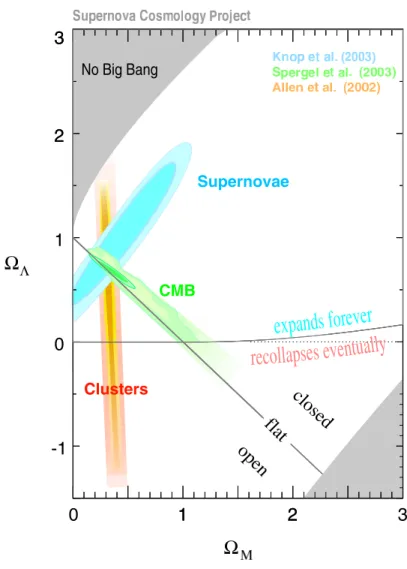
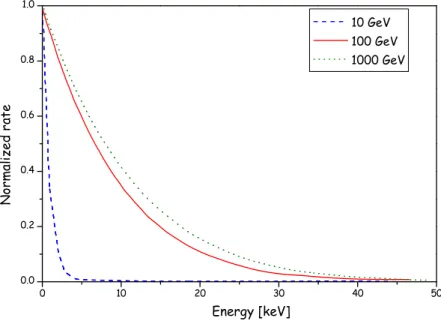
![Fig. 2.1: Detection techniques employed in the most prominent direct DM experiments. Figure taken from [31].](https://thumb-eu.123doks.com/thumbv2/1library_info/4004819.1540786/28.918.159.669.97.604/detection-techniques-employed-prominent-direct-experiments-figure-taken.webp)
